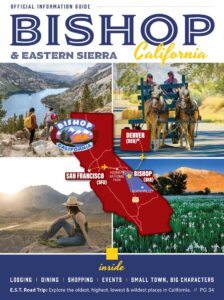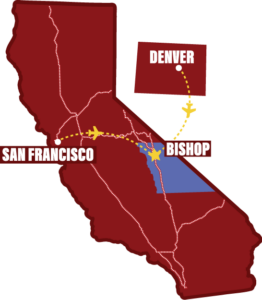The Night Sky in the Eastern Sierra
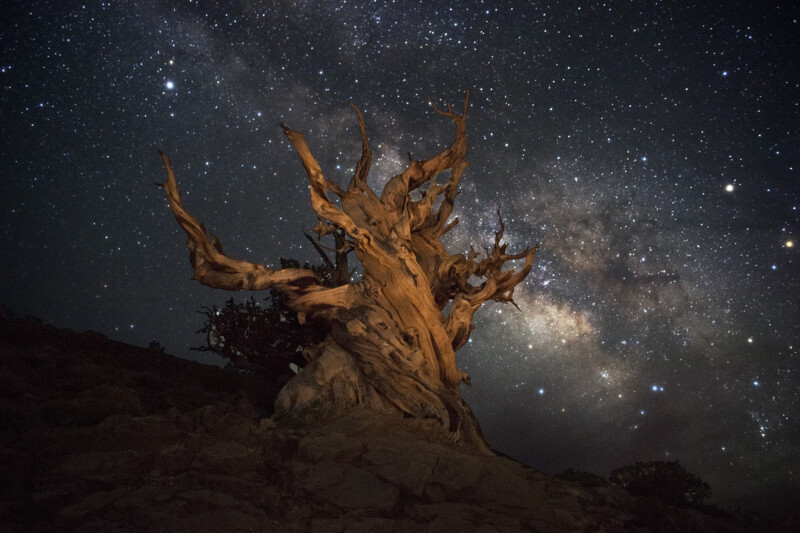
Ancient Bristlecone Pine & Milky Way. Photo: Tony Rowell
Intro
The night sky has captured the human imagination from time immemorial. Here in the Eastern Sierra the clear air and lack of light pollution make way for unimpeded visibility of the stars.
On a night when the moon is new the ribbon of the Milky Way is as obvious here today as it was when Galileo first focused his rudimentary telescope at this phenomenon in 1610 and discovered that it was made up of stars.
Today a state-of-the-art radio telescope array, affectionately known as “Big Ears,” is situated just east of Big Pine, 15 miles south of Bishop. The Owens Valley Radio Observatory (OVRO), run by the California Institute of Technology, is one of the largest university-operated observatories in the world and hosts numerous projects in radio astronomy and cosmology.
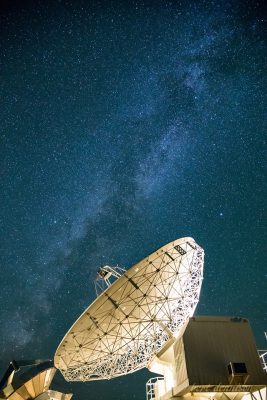
What Makes It Great
A night out under the stars can be incredibly wonderful to behold. Whether you spend only a few hours after dark or all night under the canopy of stars watching the Milky Way arc across the sky it will be a memory you will treasure forever.
On a moonless night, the stars are brilliant from just about any vantage point within the town, but a drive to some of the outlying locations will get you away from the town’s glow and give you a wide and awe-inspiring view of the sky. Full moon nights are equally spectacular, especially in winter when white snow-capped mountains reflect the moon’s glow.
This is also an awesome place to witness astronomical events like meteor showers and comets.
Who Is Going to Love It
In so many parts of the world where the spectacle of the Milky Way can no longer be seen there are countless children and adults who have never set eyes on it. This is something that all people should witness and contemplate. It is our history and our future.
What makes this all the more special is that the many places in the Eastern Sierra for night sky watching are settings with spectacular natural beauty of their own. Outdoor enthusiasts, astronomers and photographers will be enthralled and engaged by a night out in the Eastern Sierra.
At OVRO tours are given year-round on the first Monday of every month, unless it is a holiday then the tour is on the second Monday. Getting a different ‘view’ of the skies at this facility will definitely broaden your horizons. Tours start at 1 p.m. and last about an hour. Reservations are not required and there is no cost.
[button link=”https://bishopvisitor.com/venue/owens-valley-radio-observatory/”] OVRO TOURS[/button]
Best Season
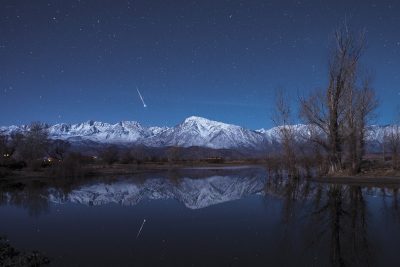
Cold, clear winter nights do present optimal conditions for night sky viewing. There are two factors that contribute to this. One is the nights are longer in the northern hemisphere. The other is that cold air holds less moisture, which means more transparency and greater clarity.
Night sky viewing is, however, a year-round activity in the Eastern Sierra and should be coordinated primarily with moon phases, the timing of astronomical events, and the weather.
Some destinations for super dark skies are not accessible during winter and the summer months offer warm, dry nights that make this a perfect time for teaching kids about the cosmos.
Best Places
Along US Highway 395 from Lone Pine, 60 miles south of Bishop, to Mono Lake, 66 miles north of Bishop, there are innumerable places to stop, hike, bivvy for a few hours, or camp overnight for stargazing.
A few miles west of Lone Pine is the Alabama Hills recreation area where a view of Mt. Whitney, the tallest peak in the contiguous USA, can be seen through a natural rock arch named the Mobius Arch. A glittering night sky with the sinuous path of the Milky Way as the backdrop is a sight to behold on a moonless night. During a full moon in winter the skyline of the Sierra Nevada and Mt Whitney will be starkly white in an azure sky with a sprinkling of twinkling stars.
High above Bishop is the Ancient Bristlecone Pine Forest. These trees, the Great Basin bristlecone pine, are the oldest living non-clonal organisms on earth and, if trees could speak, they might tell us of a slightly different sky than the one we see now. The oldest tree, Prometheus, is a little over 5,000 years old and was just a sapling when the star Thuban was the pole star at the time when the Egyptian pyramids were being built.
Close to Bishop and presenting a magnificent view of Mt. Tom and Wheeler Ridge is Buttermilk Country. Take a 10-minute drive west from town on W. Line St. – SR 168 to Buttermilk Road and turn right. Head out into Buttermilk Country as far as you wish or can (after about 10 miles on this road you may need 4×4 and high clearance) and find a turnout or clearing to spread a blanket or pitch a tent. A summer night out here is a great place for a romantic date or a late-night picnic with kids under a canopy of sparkling stars.

Near the junction of Highway 120 west, the Tioga pass road into Yosemite National Park, sits the most magnificent lake – Mono Lake. (Pronounced Moh-No.) This lake is a large, shallow, saline soda lake that lies in a closed basin. The ‘tufa towers’, calcium-carbonate spires and knobs are the unique feature of this lake, which is a protected California State Park. A nighttime visit here has an eerie, alien look from the terrestrial to the extraterrestrial.
Directions. Parking. Regulations.
Each of these areas, and the many more you may discover for yourself, will have different regulations depending on the authorities that have oversight of these places.
Begin your stargazing journey in Bishop with a visit, or phone call, to the Bishop Visitors Bureau at 690 N. Main St., (760) 873-8406, and speak with the knowledgeable staff there. Tell them what the objective is for your nighttime adventure, for example, astrophotography, cosmos for kids, or romance under the stars. We have maps, info sheets, and connections that will get you out in our backyard day or night, summer or winter for the best possible Eastern Sierra experience.
Resources & Links
Meteor Showers and Shooting Stars: Formation and History
